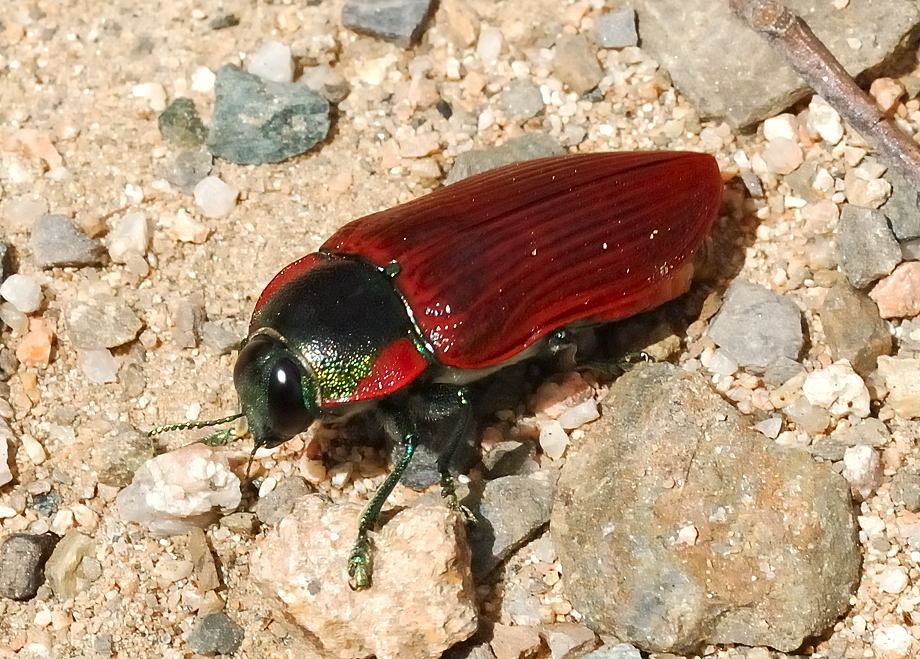|
| |
Variable Jewel Beetle - Temognatha variabilis
(Themognatha variabilis )
Family Buprestidae
- This page contains information and pictures about Variable Jewel Beetles that we
found in the Brisbane area, Queensland, Australia.
-
 - Body length 35mm
-
- This Variable Jewel Beetle body colour is highly variable.
It various from yellow to dark red. Some individuals may have red/yellow/green
patterns on wing-covers. However, the shape of the patterns on the thorax
are consistence.
-
- During a early hot summer day morning in Karawatha Forest (late Nov2006), we saw a large
beetle flied pass and rested on a River She-oak tree (Casuarina
cunninghamiana, Casuarinaceae). It was a
very large Jewel Beetle. This is the largest beetle we ever saw. We checked
that it is in Genus Themognatha, could be the Themognatha brucki.
Then we received the email from Brett
Howton suggested this is the Temognatha variabilis.
-


 -
- The Jewel Beetle was colourful. Its wing-covers were yellow in colour and gradually
became red at the end. Its thorax is dark metallic green with a
yellow spot on each side. The beetle flied to the top of another She-oak tree
after we took a few photos.
-
Second Encounter
- On early Dec 2007 in Karawatha forest, the She-oak tree forest area, we saw a dark
red Jewel Beetle on the footpath. It seemed sensing something and searching on
soil with some sort of aggressive mating action. We thought it might sensed
the pheromone leave from a female.
-
 
 -
- Those Jewel Beetles only appear in a very short period of time in the
season of a year. They are not easily be seen. It was very exciting to see a
large and colourful insect as this Jewel Beetle.
-


 -
- This dark red beetle flied away after we took the above photos. After the first
encounter of this beetle, we learned much information about this
beetle and knew their larvae live in She-oak tree of Casuarina sp.. We thought if we search
carefully, we might find more. We started to look at every She-oak tree in
that area.
-
Found Another One
- Lucky enough, without spending too much time on searching, we found another
one, a yellow form, on the base of a large She-oak tree trunk.
-


 -
- The beetle was resting there, then it started to slowly climb up on the
tree trunk.
-


 -
- After we took a few photos, it flied away.
-
- We did not sure if the beetle was waiting a mate there and went away just
because our interrupt, or it was just emerged from the She-oak tree.
-
Emerge
- We examined where the beetle was resting and found there were a few holes,
large enough for the beetle, on the base of the tree trunk just above the
roots. Those holes looked look quite old except one hole looked fresh. It was probably
the beetle just came out from there.
-


 -
- We looked around at the other She-oak trees near by and found some more
fresh new holes just at the base of those trees. Next to some holes there were
even the large empty pupa cases. This could be the case left by those newly
emerged Jewel Beetle. (Mark Hanlon sent us email and advised that : "the pupal cases you have pictured are those of a moth – buprestids do not have pupal cases – they transform from larva to pupa inside a chamber within the tree. They do not shed any layers in the
process. Emergence holes for buprestids can easily picked from moths in that they are oval in shape whereas moths tend to be more circular. Some
longicorns (particularly Phoracantha that breed in dying
eucalypts) can also have quite oval emergence holes." )
-
 -
- There were the fallen and cut She-oak trees near by. We checked those She-oak
trees and found that most of them had long tunnel inside the wood. Those
tunnels could be the homes of the Jewel Beetle larvae.
-
On Menu
 -
- Near by we found some droppings which included the Jewel Beetle
remains. We were not sure if those dropping was from bird or from other
animals. This indicated that at least those Jewel Beetle is on the diet menu
of some animals.
-
Relation with Giant Robber Fly

 -
- When we were looking for the Jewel Beetle, we also found the Giant Robber Fly
pupa (above photo) near by. We noticed that the Giant Robber Fly
Phellus olgae is also active in this time of the season. Female Giant Robber Fly
lays eggs only on She-oak tree. We also learnt that Robber fly larvae live in
wood and are also predators of eggs, larvae and other soft-bodied insects.
Those made us think that the Giant Robber fly larvae may mainly target on the
Jewel Beetle larvae inside the She-oak tree. Of course this need more
investigations to confirm.
-
- Reference:
- 1. Coleoptera
Buprestidae of Australia - Genus Themognatha, Dr.
Maurizio Gigli.
2. Wild
Plants of Greater Brisbane - Queensland Museum, 2003, p139.
- 3. Insects of Australia and New Zealand - R. J. Tillyard, Angus
& Robertson, Ltd, Sydney, 1926, p217 (Stigmodera variabilis ).
- 4. Insects of Australia, George Hangay & Pavel German, Reed New
Holland, 2000, p72.
- 5. Beetles
of Australia - Trevor J Hawkeswood, Angus & Robertson
Publishers, 1987, plate 62 (Stigmodera variabilis ).
- 6. Temognatha variabilis (Donovan, 1805) - Australian Biological Resources Study, Department of the Environment, Water, Heritage and the Arts, 2001.
[ Up ] [ Variable Jewel Beetle ] [ Castiarina Jewel Beetle ] [ Variegate Jewel Beetle ] [ Dysentery Plant Jewel Beetle ] [ Blue Banksia Jewel Beetle ] [ Circle-dotted Jewel Beetle ] [ Marble Jewel Beetle ] [ Pea Flower Jewel Beetle ]
| |
|























